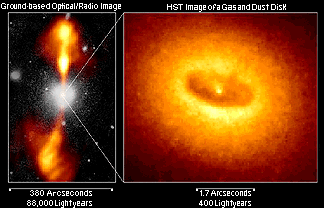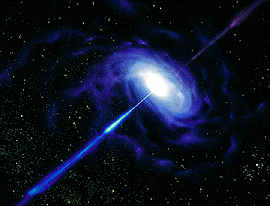Active Galaxies and Quasars
A Monster in the Middle
Most large galaxies have ~1011 Mo of stars,
~109-10 Mo of interstellar gas, and ~1012
Mo of dark matter. But at least 5% of galaxies, though it may be all of them, also have something else lurking inside...a monster in the middle!
These monsters aren't any of the typical typical horror film terrors, though they might appear in one of your favorite science fiction movies. In reality they are supermassive black holes that spew forth tremendous amounts of energy from jets on their tops and bottoms. How can these incredible objects be explained?
Long ago when galaxies were young, the stars in their cores were very
closely packed. Star collisions and mergers occurred, giving rise to a single
massive black
hole (MBH) with perhaps 106 - 109 Mo. Gas
from the galaxy's interstellar medium, from a cannibalized galaxy, or from a
star that strays too close, falls onto the MBH. As in X-ray
binary star
systems, an
accretion
disk forms, emitting huge amounts of light across the
electromagnetic
spectrum
(infrared to
gamma-rays). The MBH plus accretion disk produces the phenomena seen in
active galactic nuclei
(AGN). Below you see optical and radio images of the active
galaxy NGC 4261. The central object, accretion disk, and lobes are all
visible.

Ground Based and Hubble Space Telescope
images of the Active Galaxy NGC 4261
The different types of AGN are variations on this theme. Many galaxies today
(including our Galactic center??) may have a quiet MBH which happens not to
have recently accreted gas. Seyfert galaxies have accretion onto a
moderate-mass MBH, while the more luminous quasi-stellar objects
(i.e. quasars) have accretion onto a high-mass MBH.
In ~10% of the AGN, the MBH + accretion disk somehow produce narrow beams of
energetic particles and magnetic fields, and eject them outward in opposite
directions away from the disk. These are the radio jets, which emerge at nearly
the speed of light.
Radio galaxies, quasars, and blazars are AGN with strong jets, which can
travel outward into large regions of intergalactic space. Many of the
apparent differences between types of AGN are due to our having different
orientations with respect to the disk. With Blazars and Quasars, we
are looking down the jet. For Seyferts, we are viewing the jet broadside.
Considerable uncertainties remain. Exactly how are jets produced and
accelerated? Where do the clouds producing the broad emission lines come from?
Can we empirically confirm that a MBH is actually present?

An artists conception of an AGN
Seyferts
Consider NGC 4151, a spiral galaxy 15 Mpc away. Photographs by Carl Seyfert in
the 1940s showed a very bright point-like nucleus. Its
spectrum is very
unusual: in addition to continua + absorption lines from normal stars,
Seyfert galaxy nuclei have very strong emission lines. Some are common
lines (e.g. H-alpha, H-beta) but others are weird (e.g. twice-ionized oxygen
lines), requiring hot gas far out of equilibrium. The lines are very broad,
requiring that the gas be
Doppler
shifted in all directions up to ~20,000 km/s. The nuclei vary in brightness on
timescales of months, requiring them to be < 1 parsec in size. The total
luminosity can be equivalent to 1010 Lo!
What is this bizarre object in the center of Seyfert's spiral galaxies?
Later in the 1940s, astronomers began scanning the skies with radio
telescopes. They found strange radio structures on opposite sides of radio
galaxies, plus a tiny source of radio emission at the nucleus. The nuclei of
these radio galaxies shoot out narrow beams of extremely energetic electrons and
magnetic
fields, producing radio synchrotron
radiation. The
radio components include: the compact core at the galaxy nucleus, jets, lobes,
and a hot spot where the jet slams into the
interstellar
medium.
Quasars
In the 1960s, some radio sources seemed to be associated with 'stars', and
were called
quasi-stellar radio
sources or
quasars. But they
had spectra similar
to Seyfert galaxy nuclei! It became clear that they are Seyferts and radio
galaxies where the nucleus out shines all of the stars by factors of 10-1000. The
luminosity of quasars can reach 1012 Lo. They
also tend to be farther away than either Seyfert Galaxies or Blazars.
In the 1970-80s, findings include:
- X-ray satellite
telescopes found strong and very rapidly variable X-ray
emission from Seyferts and quasars. Timescales for these variations were as
short as days, hours, or even minutes.
- Rare BL Lac objects and blazars were discovered. These are radio galaxies
with jets pointing directly at us, ejected by the active nucleus at
velocities near the
speed of
light!
- Optical
astronomers find thousands of faint distant quasars which are not
radio-loud. Strangely, there were many more quasars early in the Universe
than there are today.
- In 1993, the Compton Gamma-Ray Observatory discovers incredibly intense
gamma-rays from the jets of some blazars: Stronger than X-ray, optical,
radio emission combined!
Blazars
Active Galactic Nuclei observed at high (>100 MeV) energies form a
subclass known as blazars; a blazar is believed to be an AGN which has
one of its relativistic jets pointed toward the Earth so that the emission we
observe is dominated by phenomena occurring in the jet region. Amongst all AGNs,
blazars emit over the widest range of frequencies, being detected
from radio to gamma-ray.
Specifically, to be classified as a blazar an AGN must be seen with one
of the following properties:
- high radio-brightness accompanied by flatness of the radio spectrum
- high optical polarization,
- strong optical variability on very short timescales (less than few
days).
In the class of objects selected according to these criteria, there
appear to be two subgroups: (1) sources showing strong and broad emission
lines, such as those of quasars (called Flat Spectrum Radio Quasars), and (2)
sources showing a featureless optical spectrum (called BL Lac objects).
There are additional important differences between these subclasses
such as they show different luminosity and redshift
distributions, and a different morphology of the extended radio
emission.
Of the 80 blazars detected already by the EGRET experiment on board the
Compton Gamma-Ray Observatory, most of them (about 80 %) are Flat
Spectrum Radio Quasars (FSRQ), while the others have been identified as BL
Lac objects.
|
